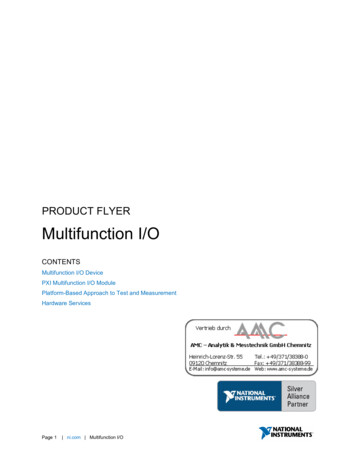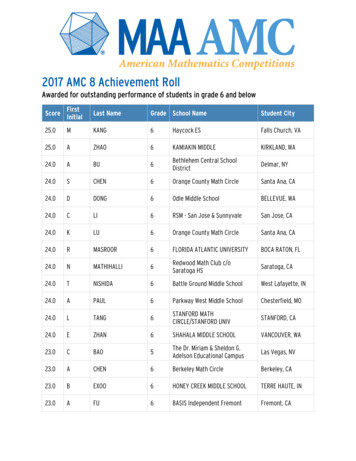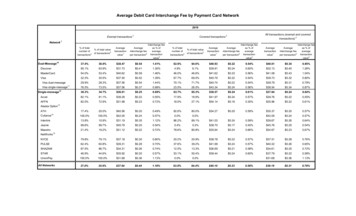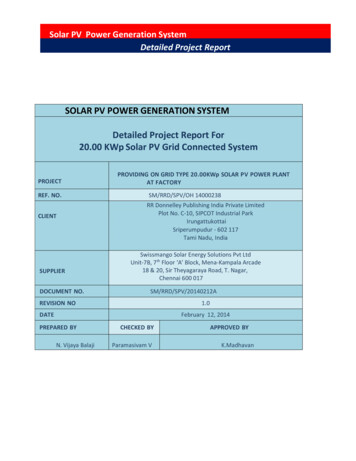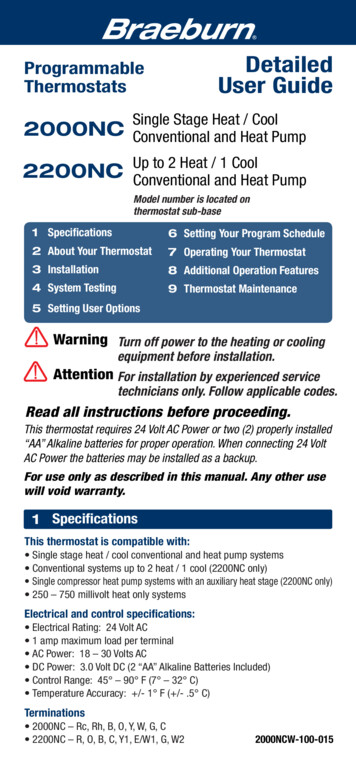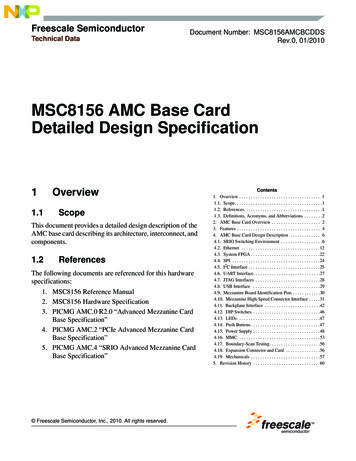
Transcription
Freescale SemiconductorTechnical DataDocument Number: MSC8156AMCBCDDSRev.0, 01/2010MSC8156 AMC Base CardDetailed Design Specification11.1OverviewScopeThis document provides a detailed design description of theAMC base card describing its architecture, interconnect, andcomponents.1.2ReferencesThe following documents are referenced for this hardwarespecifications:1. MSC8156 Reference Manual2. MSC8156 Hardware Specification3. PICMG AMC.0 R2.0 “Advanced Mezzanine CardBase Specification”4. PICMG AMC.2 “PCIe Advanced Mezzanine CardBase Specification”5. PICMG AMC.4 “SRIO Advanced Mezzanine CardBase Specification” Freescale Semiconductor, Inc., 2010. All rights reserved.Contents1. Overview . . . . . . . . . . . . . . . . . . . . . . . . . . . . . . . . . . . 11.1. Scope. . . . . . . . . . . . . . . . . . . . . . . . . . . . . . . . . . . . . .11.2. References. . . . . . . . . . . . . . . . . . . . . . . . . . . . . . . . . .11.3. Definitions, Acronyms, and Abbreviations . . . . . . . .22. AMC Base Card Overview . . . . . . . . . . . . . . . . . . . . . 23. Features . . . . . . . . . . . . . . . . . . . . . . . . . . . . . . . . . . . . 44. AMC Base Card Design Description . . . . . . . . . . . . . 64.1. SRIO Switching Environment . . . . . . . . . . . . . . . . . .64.2. Ethernet . . . . . . . . . . . . . . . . . . . . . . . . . . . . . . . . . .124.3. System FPGA . . . . . . . . . . . . . . . . . . . . . . . . . . . . . .224.4. SPI . . . . . . . . . . . . . . . . . . . . . . . . . . . . . . . . . . . . . .244.5. I2C Interface . . . . . . . . . . . . . . . . . . . . . . . . . . . . . . .254.6. UART Interface. . . . . . . . . . . . . . . . . . . . . . . . . . . . .274.7. JTAG Interfaces . . . . . . . . . . . . . . . . . . . . . . . . . . . .284.8. USB Interface . . . . . . . . . . . . . . . . . . . . . . . . . . . . .294.9. Mezzanine Board Identification Pins . . . . . . . . . . . .304.10. Mezzanine High-Speed Connector Interface . . . . .314.11. Backplane Interface . . . . . . . . . . . . . . . . . . . . . . . .424.12. DIP Switches. . . . . . . . . . . . . . . . . . . . . . . . . . . . . .464.13. LEDs . . . . . . . . . . . . . . . . . . . . . . . . . . . . . . . . . . . .474.14. Push Buttons . . . . . . . . . . . . . . . . . . . . . . . . . . . . . .474.15. Power Supply . . . . . . . . . . . . . . . . . . . . . . . . . . . . .484.16. MMC. . . . . . . . . . . . . . . . . . . . . . . . . . . . . . . . . . . .534.17. Boundary-Scan Testing. . . . . . . . . . . . . . . . . . . . . .564.18. Expansion Connector and Card . . . . . . . . . . . . . . .564.19. Mechanicals . . . . . . . . . . . . . . . . . . . . . . . . . . . . . .575. Revision History . . . . . . . . . . . . . . . . . . . . . . . . . . . . 60
AMC Base Card Overview1.3Definitions, Acronyms, and AbbreviationsTable 1 contains definitions, acronyms, and abbreviations used in this document.Table 1. Definitions, Acronyms, and Abbreviations2AMCAdvanced Mezzanine Card (AdvancedMC )ATCAAdvanced Telecommunications Computing ArchitectureBDMBackground Debug ModeBTSBase Transceiver StationCPLDComplex Programmable Logic DeviceDIPDual In Line PackageDNPDo Not PopulateDSPDigital Signal ProcessorEEPROMElectrically Erasable Programmable Read Only MemoryFPGAField Programmable Gate ArrayGETHGiga-bit EthernetHSCHigh Speed ConnectorHWHardwareI2C(bus)Inter-Integrated CircuitLTELong-Term EvolutionMTCAMicro Telecommunications Computing Architecture ( MicroTCA )RCWReset Configuration WordSRIOSerial RapidIOUARTUniversal Asynchronous Receiver/TransmitterUECUCC Gigabit Ethernet ControllerWIMAXWorldwide Interoperability for Microwave AccessAMC Base Card OverviewThe primary goals of the AMC base card are as follows: When fitted with MSC8156, mezzanine provides a high-density MSC8156 DSP reference platformin an AMC form factor Enable rapid prototyping of MSC8156-based systems for customers, third parties, and Freescale Specific targets include BTS systems for the WIMAX and LTE applications Provide design material and collateral for customers and third parties Create a third-party handover package that can be passed on to CEMs for any required productizing Provide a generic base card for future mezzanine cards, including P2020 and its derivativesMSC8156 AMC Base Card Detailed Design Specification, Rev.02Freescale Semiconductor
AMC Base Card OverviewThe AMC base card is designed to comply with the PICMG AMC.0 R2.0 specifications with AMC.4(SRIO), fitting into a single-width, full-height mezzanine card. It provides Ethernet and SRIO switchingcapability to the mezzanines as well as general board support, such as clocks and power.The mezzanine concept is designed to be flexible and to provide system-building blocks using devices,such as MSC8156, MSC815x, MSBA1000, and P2020. This allows AMC prototyping systems to bequickly enabled.SRIO traffic is routed from the backplane ports [4:7], [8:11], [12:15], and [17:20] through 10-port IDTswitch to the three mezzanines. Each mezzanine is connected to the SRIO switch through two x4 SRIOinterfaces.To facilitate PCIe development work, a single mezzanine site has its PCIe split from SRIO and routeddirectly to the backplane port [4:7] through 2:1 differential broadband Pericom PI2DBS212multiplex/de-multiplex switch.Gigabyte Ethernet traffic is routed from the two backplane ports 0 and 1, and from the two front panelsRJ45 to three mezzanines through Vitesse VSC7384 12-port RGMII switch. The transceiver ports areconfigured for RGMII to 1000-Base-X conversion and routed to the backplane, while the remaining twoports are routed to the RJ45 front panel.The FPGA collects and distributes the remaining interfacing logic, including resets, GPIOs, IRQs, LEDs,and JTAGs.A module management controller (MMC) provides board bring up and hot swap support and sequencesthe power up of all components. The MMC runs on the 3.3-V management power (IPMCV).Figure 1 shows the AMC base card and MSC8156 mezzanine architecture.NOTEThe AMC base card and MSC8156 mezzanine are jointly referred asMSC8156 AMC.MSC8156 AMC Base Card Detailed Design Specification, Rev.0Freescale Semiconductor3
FeaturesFigure 1. AMC Base Card and MSC8156 Mezzanine Architecture (MSC8156 AMC)3FeaturesThis section summarizes features of the AMC base card. Target use— System component for BTS systems, including WIMAX and LTE applications— Software development platform for WIMAX and LTE applications— Design reference and enablement platform for customers and third parties Form factor— Single-width AMC size, full-height module Connectivity— Two SRIO (x4) interfaces from backplane, “fat pipes region,” ports [4:7] and [8:11] routed tomezzanines through SRIO switch— Two SRIO (x4) interfaces from backplane, “extended pipes region,” ports [12:15] and [17:20]routed to mezzanines through SRIO switch— One mezzanine PCIe interface routed to the backplane ports [4:7] (Assembly option)— 1000-Base-X Gigabit Ethernet from the backplane ports [0] and [1] routed to mezzaninesthrough Ethernet switch and PHY— Two Gigabit Ethernet interfaces routed to front panel through PHYMSC8156 AMC Base Card Detailed Design Specification, Rev.04Freescale Semiconductor
Features — Mezzanine UART interfaces multiplexed through the FPGA to a single mini-USB Type Bconnector on the front panel through a UART/USB transceiver— Two UART ports over a single USB cable— I2C bus connecting mezzanines for boot and configuration— Serial peripheral interface (SPI) bus connecting mezzanines for boot and configuration— USB v2.0 interface for P2020 development workHardware blocks— IDT CPS-10Q 10 port SRIO switch– Two lanes of x4 SRIO from Mezzanine 1– Two lanes of x4 SRIO from Mezzanine 2– Two lanes of x4 SRIO from Mezzanine 3– Two lanes of x4 SRIO to backplane ports [4:7]– Two lanes of x4 SRIO to backplane ports [8:11]– Two lanes of x4 SRIO to backplane ports [12:15]– Two lanes of x4 SRIO to backplane ports [17:20]— Ethernet switch– Two lanes of RGMII from Mezzanine 1– Two lanes of RGMII from Mezzanine 2– Two lanes of RGMII from Mezzanine 3– Two lanes of 1000-Base-X to backplane ports 0 and 1– Two lanes of Gigabit Ethernet to front panel RJ45 connectorsBoot— Mezzanine boot options– SRIO through backplane– Ethernet through backplane or front panel– From on-board I2C EEPROM– From on-board serial Flash through SPIDebug— All JTAGs routed through FPGA to enable full BSCAN chain during factory test— JTAG header provided for MSC8156 mezzanines— COP header provided for P2020 mezzaninesModule management controller— Hot swapping— FRU storage— Status LEDs— Temperature and voltage monitoringPower supplyMSC8156 AMC Base Card Detailed Design Specification, Rev.0Freescale Semiconductor5
AMC Base Card Design Description 4— 12 V payload and 3.3 V IPMCV, provided from AMC edge connector— 12 V barrel connector for stand-alone work— On-board voltage requirements are generated through DC–DC voltage regulatorsConnectors— Three mezzanine high-speed connectors— AMC edge connector— EONCE JTAG header— Integrated RJ45 and USB type A— Mini-USB Type B (UART)— Expansion connector to offload– FPGA programming header– MMC programming header– COP JTAG header– Two RS232 (MMC)AMC Base Card Design DescriptionThis section provides the design details of various components of AMC base card, including hardwareblocks, interfaces, and general board controls (such as switches, connectors MMC, and power).4.1SRIO Switching EnvironmentThe IDT CPS10Q switch has high-performance SRIO interface that provides connectivity for control anddata plane applications. It features ten, x4 SRIO ports running up to 3.125 GHz. Six of the ports areconnected to the mezzanine connectors and four to the AMC backplane as shown in Figure 2. Out of thefour, two ports interface to the fat pipes section of the AMC connector ports—[4:7] and [8:11], and theother two ports connect the extended options, backplane ports—[12:15] and [17:20].MSC8156 AMC Base Card Detailed Design Specification, Rev.06Freescale Semiconductor
AMC Base Card Design JTAGSRIO/PCIePCIe2:1SRIO2:1SRIO SWITCH[IDT 80KSW0005]4x4x4x4x4x4x4xHSC2SRIOx TXD0 NSRIOx TXD0 PSRIOx TXD1 NSRIOx TXD1 PSRIOx TXD2 NSRIOx TXD2 PSRIOx TXD3 NSRIOx TXD3 P100ohm diff pairPort 4:7Port 8:11Port 12:154x4x4xPort 17:204xsRIO1sRIO04xFPGAMMSPD[1:0]HSC3JTAGSRIOx RXD0 NSRIOx RXD0 PSRIOx RXD1 NSRIOx RXD1 PSRIOx RXD2 NSRIOx RXD2 PSRIOx RXD3 NSRIOx RXD3 PRESETsRIO1sRIO04x4xIRQ0.1uF at device receiver endFigure 2. SRIO ConnectivityThe mezzanine SRIO interfaces to the SRIO switch, and are all identical with the exception of SRIO1 onMezzanine connector 1. This is a multiplexed SRIO/PCIe interface that connects PCIe direct to thebackplane ports [4:7] through multiplex/de-multiplex devices. For further details, refer to Section 4.1.4,“PCIe Interface.”The port mappings shown in Figure 3 are based on the AMC port positions and the pin out of the CPS10Q.Pin 1321Ethernet &SRIO Port [17:20]9 8071 CPS10Q 6253 4Port [4:7]Port [12:15]Port [8:11]Figure 3. CPS10Q Port AllocationTable 2 shows CPS10Q port allocation.MSC8156 AMC Base Card Detailed Design Specification, Rev.0Freescale Semiconductor7
AMC Base Card Design DescriptionTable 2. CPS10Q Port AllocationPortSignal (Net name)End PointCPS10QSignal NameCPS10QIO0M2 SRIO0 TXD[0:3] PM2 SRIO0 TXD[0:3] NMezzanine 2SRIO0RX[0:3] RX[0:3]I0.1 μFat CPS10QpinsTX[0:3] TX[0:3]-OOn mezzanineRX[4:7] RX[4:7]-I0.1 μF at CPS10QpinsTX[4:7] TX[4:7]-OOn mezzanineRX[8:11] RX[8:11]-I0.1 μF at CPS10QpinsTX[8:11] TX[8:11]-OOn mezzanineRX[12:15] RX[12:15]-I0.1 μF at CPS10QpinsTX[12:15] TX[12:15]-OOn mezzanineBackplaneSRIO1Ports [8:11]RX[16:19] RX[16:19]-I0.1 μF at CPS10QpinsTX[16:19] TX[16:19]-ODirect connection toAMC edge connectorBackplaneSRIO2Ports[12:15]RX[20:23] RX[20:23]-I0.1 μF at CPS10QpinsTX[20:23] TX[20:23]-ODirect connection toAMC edge connectorBackplaneSRIO0Ports[4:7]RX[16:19] RX[16:19]-I0.1 μF at CPS10QpinsTX[16:19] TX[16:19]-OConnection to AMCedge connector bymultiplexingBackplaneSRIO3Ports[17:20]RX[28:31] RX[28:31]-I0.1 μF at CPS10QpinsTX[28:31] TX[28:31]-ODirect connection toAMC edge connectorMezzanine 1SRIO0RX[32:35] RX[32:35]-I0.1 μF at CPS10QpinsTX[32:35] TX[32:35]-OOn mezzanineM2 SRIO0 RXD[0:3] PM2 SRIO0 RXD[0:3] N1M2 SRIO1 TXD[0:3] PM2 SRIO1 TXD[0:3] NMezzanine 2SRIO1M2 SRIO1 RXD[0:3] PM2 SRIO1 RXD[0:3] N2M3 SRIO0 TXD[0:3] PM3 SRIO0 TXD[0:3] NMezzanine 3SRIO0M3 SRIO0 RXD[0:3] PM3 SRIO0 RXD[0:3] N3M3 SRIO1 TXD[0:3] PM3 SRIO1 TXD[0:3] NMezzanine 3SRIO1M3 SRIO1 RXD[0:3] PM3 SRIO1 RXD[0:3] N4AMC SRIO1 TXD[0:3] PAMC SRIO1 TXD[0:3] NAMC SRIO1 RXD[0:3] PAMC SRIO1 RXD[0:3] N5AMC SRIO2 TXD[0:3] PAMC SRIO2 TXD[0:3] NAMC SRIO2 RXD[0:3] PAMC SRIO2 RXD[0:3] N6AMC SRIO0 TXD[0:3] PAMC SRIO0 TXD[0:3] NAMC SRIO0 RXD[0:3] PAMC SRIO0 RXD[0:3] N7AMC SRIO3 TXD[0:3] PAMC SRIO3 TXD[0:3] NAMC SRIO3 RXD[0:3] PAMC SRIO3 RXD[0:3] N8M1 SRIO0 TXD[0:3] PM1 SRIO0 TXD[0:3] NM1 SRIO0 RXD[0:3] PM1 SRIO0 RXD[0:3] NDC blocking capMSC8156 AMC Base Card Detailed Design Specification, Rev.08Freescale Semiconductor
AMC Base Card Design DescriptionTable 2. CPS10Q Port Allocation (continued)PortSignal (Net name)End PointCPS10QSignal NameCPS10QIO9M1 SRIO1 TXD[0:3] PM1 SRIO1 TXD[0:3] NMezzanine 1SRIO1RX[36:39] RX[36:39]-I0.1 μF at CPS10QpinsTX[36:39] TX[36:39]-OOn mezzanineM1 SRIO1 RXD[0:3] PM1 SRIO1 RXD[0:3] N4.1.1DC blocking capCPS10Q ConfigurationThe CPS10Q can be programmed through two different interfaces: In band through CPU/ DSP attached to one of the SRIO ports Out of band through either the I2C or JTAGTypically, a CPU/DSP attached to an SRIO port is used for configuration. However, the option also existsto configure the device through I2C configuration memory, enabling the user to run the CPS10Q in remotestand-alone mode.The JTAG interface of CPS10Q can be used for BSCAN and JTAG tools access. The JTAG interface isconnected to the FPGA, where it can be configured for BSCAN testing or routed to one of the exis
† Enable rapid prototyping of MSC8156-based systems for customers, third parties, and Freescale † Specific targets include BTS systems for the WIMAX and LTE applications † Provide design material and collateral for customers and third parties † Create a third-party handover package that can be passed on to CEMs for any required productizing † Provide a generic base card for future .
